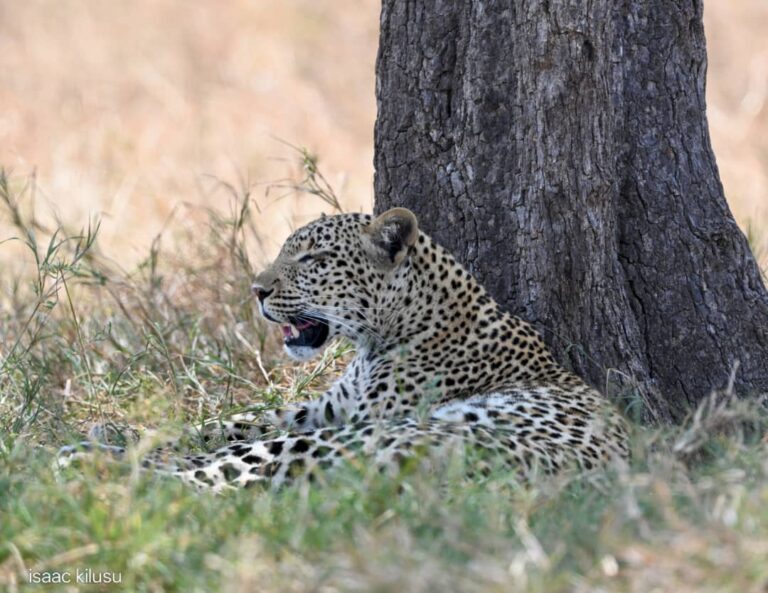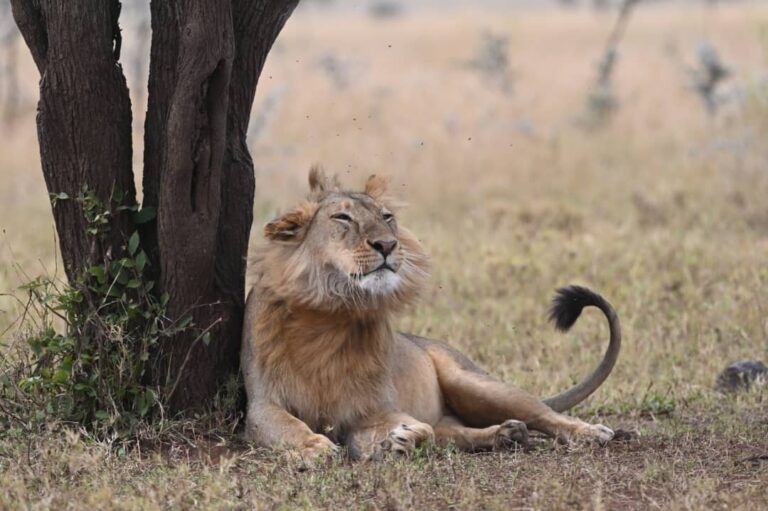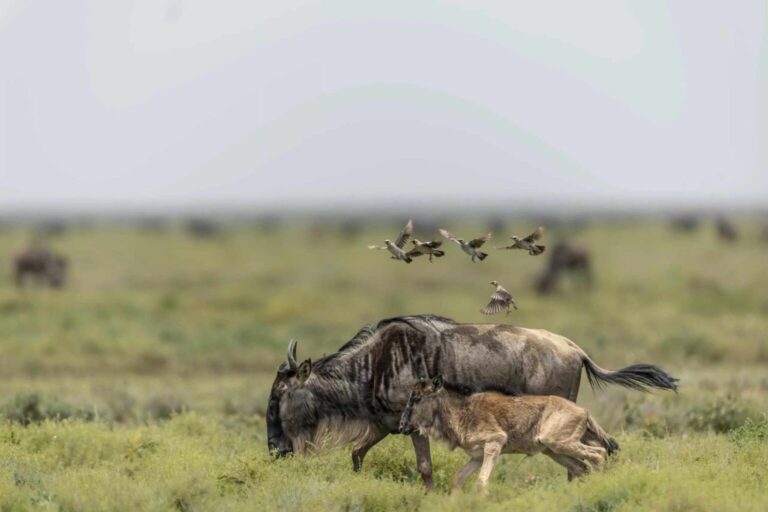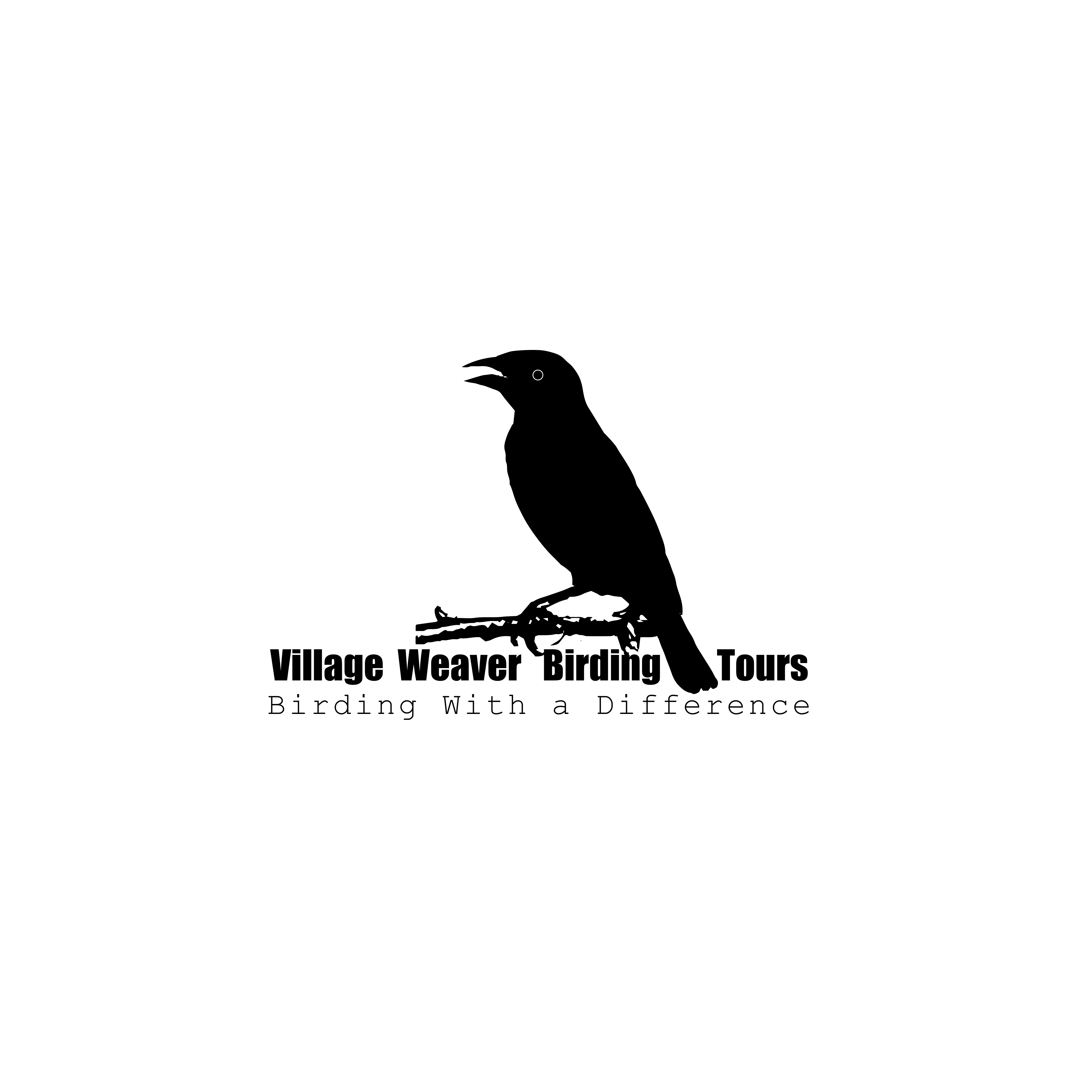Northern Tanzania Birding and Big game safari
Tour Leader: Issac Kilusu Guests: Pedro, Teresa and Pilar – Spain
Day 1: Lark Plains – 1st November 2024
We picked up Pedro and his two friends, Teresa and Pilar, from Tulia Hotel and Boutique in Arusha town at around 2 pm. After hitting the Namanga Road, we drove straight towards the plains. Just past Ngaramtoni ya Juu, we had brief views of Long-tailed Fiscal, Northern Fiscal, and Speckled Pigeon perched on the power lines near the cultivations. Further along, past the military area, a Common Kestrel was also sitting on the power line, though we didn’t stop due to the proximity to the military zone.
As we approached the Lark Plains, still under the hot and windy conditions, I decided to stop at an old, secret birding spot I’ve used before. We parked at the obvious marketplace at Oldonyo Sambu and walked towards the ravine. Here, we quickly registered Kenya Sparrow, Pied Crow, Brubru, Abyssinian Wheatear, White-bellied Canary, and Variable Sunbird. An African Paradise Flycatcher flew by, and a Brown-crowned Tchagra sat in the dead acacia branches for a few seconds.
On the other side of the ravine, two Southern Grosbeak Canaries shared a tree with a male Vitelline Masked Weaver in full breeding plumage, accompanied by two females. We walked a few more metres down and tried the usual spot for Little Rock Thrush. Although it responded, it never showed itself.
We also heard Nubian Woodpecker, Abyssinian Scimitarbill, Northern Red-fronted Tinkerbird, and Greater Honeyguide calling near the large rock fig. We decided to head there, where we spotted a few Red-billed Firefinches, Red- and Yellow-barbet, Red-winged Starlings, Scarlet-chested Sunbird, and a lone Abyssinian Scimitarbill still calling unhappily from the nearby Acacia tortilis.
By 4:00 pm, we returned to the main road and called Olacs, our driver, who picked us up. We drove straight to the plains, adding Black-chested Snake Eagle and Buff-crested Bustard on the way.
Taking the right turn towards the plains, we spotted two Taita Fiscals perched on the short acacia trees, scanning the vast, dusty plains. A female Pygmy Falcon was perched on a power line, and a migrant Northern Wheatear was negotiating its way through the short bushes nearby, trying to hide from us. Further down, towards our usual parking spot, we encountered two African Pipits, Fawn-coloured Larks, and several Capped Wheatears. At the parking area, we found a group of Chestnut-bellied Sandgrouse.
In the distance, we saw the two Maasai guides searching for the rare and critically endangered Beesley’s Lark. We walked towards them, but they had not seen anything. Each of the guides went in a different direction, and I headed northwards. After some time searching, I spotted a Beesley’s Lark foraging. I tried to point it out to the guests, but it was too quick for them. Further along, I saw three birds scratching the ground. Through my binoculars, I couldn’t believe they were Beesley’s Larks. A Capped Wheatear joined them, and three more Beesley’s Larks appeared. We spent some time observing them before I suggested we head east to search for Short-tailed Lark. Unfortunately, we missed it, but we did find Hildebrandt’s Starling, two Kori Bustards, and Red-fronted Prinias.
As it was getting late, we returned to the car and drove straight back to the hotel.
Day 2: Arusha National Park – 2nd November 2024
We started early, leaving the hotel grounds by 6:45 am, and took the bypass road to avoid the morning traffic. Along the way, we made a few stops and spotted Fan-tailed Widowbird, Superb Starling, Reichenow’s Seed-eater, and Singing Cisticola. We later joined the Moshi-Arusha road, turning left towards the park. At the main gate, we recorded Taveta, Village, and Chestnut Weavers. A Scaly Spurfowl was heard calling from the thickets, but we decided not to call it out as I had a better spot for that species later.
After completing the paperwork and check-in procedures, we drove along the park’s main road, adding Bronzy Sunbird, African Stonechat, and Moustached Grass Warbler to our list. As we entered the open area known as “Serengeti Ndogo” (Swahili for “Little Serengeti”), we observed Warthogs, Cape Buffalo, Giraffes, Zebras, Bushbucks, and a Slender Mongoose. Birds included Western Cattle Egret, Yellow-billed Egret, Great Egret, Hamerkop, and Grey Heron.
We took the right road towards the Ngurdoto Museum, stopping at the Trilling Cisticola site where we had excellent views, and as a bonus, we spotted an African Firefinch. At the museum’s washrooms, nearby trees yielded White-eared Barbet, Narina Trogon, Olive Sunbird, and Collared Sunbird.
Continuing towards the Ngurdoto Crater, we stopped to observe Kilimanjaro White-eye, Placid and Stripe-faced Greenbul, Black-fronted Bush-shrike, and Silvery-cheeked Hornbill. Turning left towards the Leitong viewpoint, we added Black-headed Apalis, African Dusky Flycatcher, and heard Hartlaub’s Turaco calling in the distance.
We then retraced our route, driving towards the Small Momela Lakes for a picnic lunch. On the way, a brief stop in a marshy area produced sightings of White-backed Ducks, African Jacana, Purple Heron, and White-faced Whistling Ducks.
At the picnic site, we spotted Tropical Boubou, Scaly Spurfowl, European Bee-eater, Banded Martin, and Baglafecht Weaver. After lunch, we headed to the Big Momela Lakes, where we added Greater and Lesser Flamingoes, Cape Teal, Southern Pochard, Long-billed Pipit, Black-winged Stilt, Whinchat, Martial Eagle, and African Harrier Hawk to our list.
As the day drew to a close, we drove towards Momela Gate, rejoining the main road to exit the park. Along the way, we were fortunate to spot the elusive Forest Duiker and the Suni Antelope.

Day 3: Tarangire National Park – 3rd November 2024
We left our hotel in Arusha by 6:30 am and drove straight to Tarangire NP. Just at the main gate, where they recently placed some water baths for birds, we had plenty of Swahili Sparrows, Yellow-collared Lovebirds, Blue-capped Cordon-bleus, White-headed Buffalo Weavers, and Fork-tailed Drongos. After the paperwork, we drove towards Public Campsite No. 1 and saw several Ashy Starlings foraging on the ground. A Northern Red-billed Hornbill was also in the party, together with some Wattled Starlings.
We came toward Dimbwi la Saladi (a waterhole filled with water cabbage), and there were a few Darnaud’s Barbets nearby, Woodland Kingfishers, Northern Pied Babblers, Verreaux’s Eagle Owl, and Lilac-breasted Rollers.
We followed the Mnazi loop and didn’t record any new birds. Only Lesser and Greater Honeyguides were heard calling several times. We changed our initial plans because it was almost lunchtime and decided to explore the River Circuit, hoping some big game would come out to drink. We did see a pride of Lions resting under the acacia trees, and on the other side, a big herd of Elephants was also resting under trees after their afternoon drink.
We also saw very few birds in this loop, but we were happy with our new additions: Bateleur, Red-necked and Yellow-necked Spurfowls, Black Stork, Common Greenshank, and Grey-crowned Cranes. We later went towards the Poacher’s Hideout and stopped there for lunch. After lunch, we birded the area on foot and saw Red-chested Cuckoo, Green Wood-hoopoe, Crowned Lapwing, and Mottled Spinetail.
We drove slowly towards Sangaiwe Gate, where we registered Diederic Cuckoo, White-bellied Go-away Bird, Red-headed Weaver, Orange-breasted Bush-shrike, Von der Decken’s, and Southern Ground Hornbill.


Day 4: Tarangire National Park – 4th November 2024
We started birding at Sangaiwe Campground on our way out by 6:30 am, and we had Eastern Violet-backed Sunbird, Black Cuckoo, Yellow-bellied Eremomela, and Reichenow’s Seed-eater. We drove past the Sangaiwe Gate, birding slowly downwards, and the plan was to visit the Silalei Swamp, which is the lifeline of the park in the dry season. On the way, we had new birds for the trip, such as Pearl-spotted Owlet, Black-lored Babbler, Hildebrandt’s Spurfowl, Yellow-billed Stork, African Spoonbill, Marabou Stork, Green-winged Pytlia, and Croaking Cisticola.
We had lunch at the Silalei Picnic Site, and there were Silverbirds and Emin’s Barbet. After lunch, we drove to the edge of the swamp, where we recorded Rufous-bellied Heron, Long-toed Lapwing, Squacco Heron, Long-crested Eagle, and Brown Snake Eagle. We spent some quality time watching elephants enjoying a wash in the swamp, then headed back to camp, arriving at around 6:00 pm.

Day 5: Endoro Cave Trail – 5th November 2024
We left Sangaiwe Camp at 6:30 am and arrived at Endoro Gate near Gibbs Farm at 10:30 am. We quickly checked in and started birding on the main trail. We had Grey-capped Warbler, Brown-headed Apalis, Bar-throated Apalis, White-tailed Blue Flycatcher, Thick-billed Seed-eater, African Hill Babbler, Crowned Eagle, and Cinnamon-chested Bee-eater. We reached the Elephant Caves, where we saw Eastern Double-collared Sunbird, Mbulu White-eye, and Schalow’s Turaco. We walked back to the main gate and drove to a picnic stop, then headed to Bougainvillea Safari Lodge in the evening for the night.
Day 6: Ngorongoro Crater Floor – 6th November 2024
As usual, we left early with lunch boxes, and we made a stop at the Ngorongoro Viewpoint. We enjoyed the breathtaking views of the crater and took a few photos before driving straight to the Seneto Descent Road. There, we birded for Lyne’s Cisticola, Augur Buzzard, White-necked Raven, and Streaky Seed-eater. After checking in, we birded down to the crater floor and on to Lake Magadi, where we saw waterbirds such as Chestnut-banded Plover, Black-winged Stilts, both Flamingos, Ruff, Marsh and Wood Sandpipers, Spur-winged Goose, and many more.
We drove past Enkitati Hill and encountered two Lions resting near the road. We took another stop before proceeding up and birded for Ant-eating Chat, Jackson’s Widowbird, and Fan-tailed Widowbird. We later drove to the Engoitokitok Picnic Site, where we had lunch, and saw Speke’s Weavers, Marabou Storks, and a few Yellow-billed Kites roaming around.
After lunch, we took the left turn off towards Elerai Forest, and on the way, we saw a Black Rhino with a calf. We took another stop for pictures and birded Lerai Forest for some time before driving out of the crater via the Lerai Ascend Road.
Little Bee-eater

Day 7: Serengeti National Park – 7th November 2024
We left early with lunch boxes, and our first stop was Nyati Transit Picnic Site at the crater rim. We birded for Golden-winged Sunbird, Tacazze Sunbird, Hunter’s Cisticola, Red-cowled Widowbird, and Cinnamon Bracken Warbler. We drove for a few hours and took another stop at the junction to the Olduvai Gorge Museum. We took a walk around but didn’t record any new birds. We continued on to the Golini Junction, where we registered Greater Kestrel, and two African Golden Wolves were seen there. Further up on the left, six Hyenas were sunning themselves in a muddy pool.
We reached Naabi Hill Gate and birded around for an hour. We had lunch and continued, taking the right road to Villima Saba (Seven Hills). Just at the turn-off, we saw Grey-backed Fiscal, White-tailed Lark, Cape Crow, and Grey-breasted Spurfowl. We drove towards Maasai Kopjes, where we encountered a very large herd of Buffalo, Zebras, and Wildebeest, as well as three Cheetahs in three different locations.
We took another stop at Naabi Hippo Pool before driving up to Kumi na Sita Junction and then down to Nyuma ya Nyumba at another Hippo Pool, where we saw Rüppell’s Starling. It was getting late, so we decided to drive straight to camp. Just at the junction to camp, I noticed a large flock of vultures on the trees, and I knew there was a kill nearby. We turned right, then left at the bank of the river, where we saw a large pride of Lions with a Buffalo kill. We spent time there until it was dark before heading back to camp.
Day 8: Serengeti National Park – 8th November 2024
We started early in the morning and birded the campground for Buff-bellied Warbler, Usambiro Barbet, and other birds we had previously seen. We revisited the lion kill from the previous evening to see if any new vultures had arrived, but there was nothing there. We saw many migrating Wildebeest around that area, and a few African Green Pigeons.
We drove to Retima Hippo Pool, looking for Crocodiles, and then headed up to the road that goes west. Past the Hembe Game Viewing Circuit, we saw thousands of Wildebeest heading southwest into the central Serengeti. We tried an obvious spot for Maasai Apalis, but it proved futile.
We decided to drive back to Central Serengeti for lunch. After lunch, we ventured down to the short grassy plains on the eastern side, where we saw Temminck’s Courser, Caspian Plover, Black-winged Lapwing, and Flappet Lark. We went further to the Kopjes, searching for a Leopard, but we didn’t find it. Later, we drove to the last Kopjes near Seronera and crossed over to Nyuma ya Nyumba Loop. There, we observed a pride of Lions attempting to hunt Zebras, but unfortunately, the Zebras spotted the Lions before they could make a move.
It was getting late, and we decided to drive straight to camp. Just after the junction to Kubukubu Camp, I noticed a carcass hanging in a tree near the road. We stopped to take a look, and yes, it was still fresh. On the other side of the tree, we saw a Male Leopard sitting there with a full stomach. We were delighted—what a fantastic way to end the day!

Day 9: Serengeti to Arusha – 9th November 2024
After breakfast, we packed up and drove out of our beautiful camp. Just a few hundred metres down the road, we encountered a lone Lion walking towards the Orangi River. We took a few pictures and left it to continue its business.
At the Orangi River, there was a Hippopotamus basking out of the water. Once again, we had a quick photo session before driving straight to the place where we had left the Leopard the previous evening. To our surprise, only a small portion of the carcass remained, and the Leopard was no longer on the tree. We scanned the nearby bushes and spotted the Leopard’s head popping out. After taking a few head shots, it moved out into the open and headed towards a larger bush nearby. We quickly secured better shots before it dashed completely into the bush.
We drove towards Naabi Hill Gate, did some paperwork, and then proceeded straight to Arusha, where we checked in at Medan Hotel, arriving close to 4:00 in the evening.
Conclusion:
Our birding tour across Tanzania’s northern circuit was an unforgettable adventure and success, offering a remarkable array of bird species and wildlife encounters. From the vibrant birdlife of Tarangire National Park to the dramatic landscapes of the Ngorongoro Crater and the vast plains of Serengeti, every day brought new experiences and new sightings. We were fortunate to witness rare sightings, such a leopard with a kill, and to observe an impressive range of birds, including sunbirds, cuckoos, and storks, among many others. With stunning landscapes, diverse ecosystems, and unforgettable wildlife moments, this journey through northern Tanzania was a true celebration of nature’s beauty.
Total number of species observed:
323
